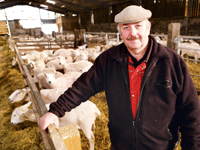Winter shearing boost performance

Shearing pregnant ewes at housing can increase stocking density by at least 25%, according to a sheep producer who shears his entire flock six weeks before lambing.
Fat lamb producer Richard Issac says he can house ten additional ewes a pen by clipping out of season.
Mr Issac started winter shearing five years ago, initially as an experiment involving 100 ewes. “We were so pleased with the results we now shear all 650 at the end of January, before they start lambing on 20 March,” he says.
Increasing stocking density is not the only advantage, says Mr Issac, who runs a mixed flock of Welsh ewes, mules and Texel-crosses in Wales. Shorn ewes have greater appetites and therefore eat more, typically 10-15% more than those in full wool. This results in heavier lambs at birth, a definite advantage. “We have had less mortality because lambs are stronger when they go out to grass,” he says.
But with very high-quality fodder, the total feed intake may have to be restricted to avoid large lambs, which can result in difficult births. This is particularly relevant to single lambs.
Mr Issac only gives his ewes additional silage after lambing – he doesn’t increase concentrate intakes. The ewes are housed in draught-free sheds with plenty of bedding.
Research by Scottish Agricultural College sheep specialist John Vipond confirms that lambs born to winter shorn ewes are on average 0.4kg-0.5kg heavier. This is not only the result of higher feed intakes but also because many lambs are born one-and-a-half days later. “Pregnant ewes housed with full fleeces get hot and develop heat stress, so they are less likely to carry their lambs to full term,” Mr Vipond explains. “Removing their fleeces reduces body temperature and respiration rates so they are more comfortable in the latter stages of their pregnancies.”
Although Mr Issac has been able to house 25% more ewes on his farm at Ynysybwll, Pontypridd, thanks to winter shearing, Mr Vipond’s research suggests this figure can be up to 30%, depending on the size of the ewe and the sort of fleece it grows. “The ewes can move past each other more easily,” he says.
Mr Vipond recommends shearing as soon as ewes are housed, between six and eight weeks before turnout. This allows sufficient time for re-growth before turnout to provide a level of protection during bad weather. Factors including the breed, the length of wool left after shearing and feeding will influence the rate of re-growth.
Fleeces should be 12mm (0.5 inch) long at turnout. Wool removed at this time of the year will be of superior quality to summer fleeces because it is only part grown and cleaner.
An obvious advantage to shearing before turnout is that ewes don’t need to be rounded up again for shearing once they have been turned out to grass, says EBLEX beef and sheep scientist, Dr Liz Genever.
But she says ewes must be assessed individually to gauge their suitability for winter clipping. “When ewes are below a condition score of 2.5, they shouldn’t have their fleeces removed,” says Dr Genever. She also advises against shearing ewes carrying triplets.
Good shelter is essential for shorn ewes. Even though Mr Issac’s land ranges from between 900 and 1100 feet, he says he has never had an issue with ewes and lambs suffering the effects of bad weather. “Even though we are on high ground, every field has a slope so the sheep can find shelter if they need to,” he says.
“There are advantages in them not having thick fleeces when they go out to grass because they don’t carry excessive water and muck, they can shake off the rain.”
Their lambs are also more likely to be protected from the weather because a shorn ewe will tend to seek shelter, taking her lamb with her, while an unshorn ewe is less likely to do so.
A disadvantage to winter shearing can be the availability of contractors, but Mr Issac reckons it can be easier to hire shearers in the winter. He uses a local contractor who is experienced at winter shearing.
The only disadvantage Mr Issac has experienced is the high volume of wool winter shorn ewes carry at tupping time.
He says some farmers overcome this by shearing the ewes’ tails, but timing is important. “This should be done either a month before tupping or just before letting the rams in to avoid prickly regrowth at tupping,” he says.
